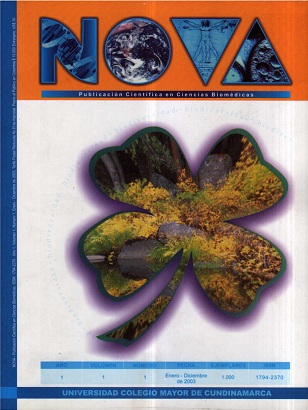Etiología bacteriana de infecciones oculares externas
Bacterial etiology of external ocular infections in patients that live together or not with animals.

NOVA por http://www.unicolmayor.edu.co/publicaciones/index.php/nova se distribuye bajo una Licencia Creative Commons Atribución-NoComercial-SinDerivar 4.0 Internacional.
Así mismo, los autores mantienen sus derechos de propiedad intelectual sobre los artículos.
Mostrar biografía de los autores
En esta investigación fueron evaluados 286 pacientes que presentaron conjuntivitis bacteriana como impresión diagnóstica más frecuente. En 286 cultivos microbiológicos realizados se obtuvieron 177 aislamientos bacterianos, encontrándose un 73.45% de flora Gram positiva siendo las especies más frecuentes S. epidermidis (48.46%), S. aureus (35.38%),S. pneumoniae (4.61%) y Corynebacterium sp. (2.31%). El 26.55% correspondió a bacilos Gram negativos de los cuales el 74.47% son enterobacterias y el 25.53% microorganismos no fermentadores. En este estudio no se encontró diferencia significativa entre la convivencia o no con animales y tipo de microorganismo aislado asociado a zoonosis.
Visitas del artículo 1649 | Visitas PDF 853
Descargas
- O’Brien TP, Hazlett L. Ocular Microbiology: Pathogenesis of ocular infection; 2000.
- Ang T, Khan PK. Nossocomial Klebsiella pneumonia conjunctivitis resulting in infections keratitis ambilateral corneal perforation. Arch Ophthalmology 1996 Apr;114(4):933-6. 2. Walker S. Microbiología. México: Mc Graw-Hill Interamericana; 2000.
- Dissanaike AS, Jayaweera CD, Padmini HH, Ihalamulla RL, Naotunne T. Recovery of a species of Brugia, probably B. ceylonensis from the conjuntiva of a patient in Sri Lanka. Ann Tropical Med & Parasitol 2000;94(1):83-6.
- Knoor HL, Weber A. Ocular manifestations of selected zoonoses in human. Tierarztl Prax 1992;20(4):347-54.
- -------------------------------------------------------------------------------
- DOI: http://dx.doi.org/10.22490/24629448.1056
- Rathinam S, Cor E, Alex JC, et al. Leptospiral antibodies among human beings in Tamilnadu. Indian J Med Microbiol 1993;11:203-5.
- Falck G. GroupAstreptococci in household pets eye a source of infection in humans. Scand J Infect Dis 1997;29(5):469- 71.
- Glickman LT, Magnaval JF. Zoonotic roundworm infections. Infect Dis Clin North Am 1993;7(3):717-32.
- Marlin D. Conjunctivitis, Bacterial. Hospital Los Angeles Medical Center, Health Science Center and University of Arkansas for Medical Science; 2001 Aug: 4-9.
- Bruce Jackson W. Diagnosis and treatment eye. The Ottawa Hospital, Eye Institute; 2001.
- Syed NA, Hyndiuk RA. Infectious Conjunctivitis. Infectious Disease Clinics of North America; 1992 Dic;6(4):789-805.
- Niranjan N, Gita S. Slime production as a virulence factor in Staphylococcus epidermidis islated from bacterial keratitis. Indian Journal of Medical Research 2000 Jan;111:6-11.
- García-Saenz MC, Peral Ortiz de la Torre MJ, De Castro LM, Jiménez Martínez E, García Sánchez JE, Fresnadillo MJ. Flora conjuntival según edades. Archivos Sociedad Española de Oftalmología; 1999 Jul;(7):1-7.
- Schaefer F, Bruttin O, Zografos L, Guex-Crosier Y. A prospective clinical and microbiological study. British Journal of Ophthalmology 2001 Jul;85(7):842-8.
- Otto S, Aydin P, Cifetciogu N, Dursun D. Slime production by coagulase-negative staphylococci isolated in chronic blepharitis. Eur J Ophthalmol 1998;8(1):1-3
- Srinivasan M, González A, Celine G, Cevallos V. Epidemiology and aetiological diagnosis of corneal ulceration in madural, South India. British Journal of Ophthalmology 1997 Nov;29(11):965-72.
- Scott UI, Flynn HW, FeuerW, Pflugfelder, Forster RK, Miller D. Endophthalmitis associated with microbial keratitis. Ophthalmology 1996 Nov;103(11):1864-70.
- Modarres SH, Lashell A, Oskoii N. Bacterial etiologic of ocular infection in children in the Islamic republic of Iran. Ocular infection;4(1):44-49
- Dennis P. Hans and the Endophthalmitis Vitrectomy Study Group. Microbiologic Factor and Visual Outcome in the Endophthalmitis Vitrectomy Study. American Journal of Ophthalmology 1996 Dec;122:830-46.
- Mezer E, Gelsand YA, Lottan R, Tamir A, Miller B. Bacteriological profil of ophthalmology infection in and Israeli Hospital. Eur-J-ophtalmol 1999 Apr- Jul;9(2):120-4.
- Koneman EW, et al. Diagnóstico Microbiológico. Brasil: Ed. Panamericana, 2000. 22. Reynolds HY. Pneumonia due to Klebsiella. In:Wyngaarden JB, Smith LH, editors. Cecil textbook of Medicine. 16th ed. Philadelphia; 1982.
- Rathinam SR, Rathnam S, Suresh B, et al. Leptospiral antibodies in patients with recurrent ophthalmic involvement. Indian J Med Res 1996;103:66-8.





